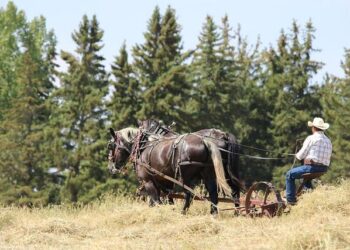Numerous rivers and streams in Alaska’s remote Brooks Range are turning orange due to the thawing of permafrost, which is releasing previously frozen minerals into the water.Water samples from the affected streams show higher acidity and higher concentrations of sulfates and trace metals, which can have significant ecological consequences, such as the disappearance of fish species and a decline in aquatic insect diversity.These water quality changes could severely impact Arctic fish populations, as many of the affected streams serve as crucial spawning grounds and nurseries for salmon and other fish species that are essential to the ecosystem and local subsistence fisheries.Researchers emphasize the need for further studies to understand the long-term implications of this issue, highlighting that the abrupt changes in water chemistry observed in the Brooks Range are a unique and concerning consequence of climate change in the Arctic.
Dozens of once-pristine rivers and streams in Alaska’s Brooks Range are turning an alarming shade of orange. The discoloration, according to a new study published in the journal Communications Earth and Environment, is likely caused by the thawing of permafrost, which is exposing previously frozen minerals that are now leaching into the waterways.
The research team, led by ecologist Jon O’Donnell from the U.S. National Park Service, documented 75 locations across a vast area of northern Alaska where the crystal-clear waters now appear heavily stained. Using satellite imagery and field observations, the scientists determined that the onset of this discoloration coincided with a period of warming and increased snowfall in the region over the past decade.
Permafrost, which is ground that remains frozen year-round, acts as a storage vault for various minerals. As rising temperatures cause this frozen layer to thaw, these minerals are exposed to water and oxygen, triggering chemical reactions that release iron and other metals into the groundwater. This metal-rich water then makes its way into the once-untouched rivers and streams.
 Map of orange stream observations across Arctic Inventory and Monitoring Network (ARCN) parks in northern Alaska. Picture inserts show aerial images of select iron-impacted, orange streams. Map created by Carson Baughman, U.S. Geological Survey. Photos by Kenneth Hill, National Park Service. Public domain.
Map of orange stream observations across Arctic Inventory and Monitoring Network (ARCN) parks in northern Alaska. Picture inserts show aerial images of select iron-impacted, orange streams. Map created by Carson Baughman, U.S. Geological Survey. Photos by Kenneth Hill, National Park Service. Public domain.
Water samples collected from the affected streams revealed lower pH levels and higher concentrations of sulfates and trace metals compared to nearby unaffected waterways. In some cases, the pH levels dropped to 2.3, similar to the acidity of vinegar. The presence of elevated levels of iron, zinc, nickel and copper is the primary cause of the color change.
“Our recent study highlights an unforeseen consequence of climate change on Arctic rivers,” study co-author Brett Poulin, an environmental toxicologist from the University of California, Davis, told Mongabay. “Arctic environments are warming up to four times faster than the globe as a whole, and this is resulting in deterioration of water quality in the most pristine rivers in North America.”
 Impacts of iron mobilization in a stream tributary of the Akillik River located in Kobuk Valley National Park, Alaska. These images were taken two years apart. The clear picture was taken in June 2016 and the orange picture was August 2018. Photos by Jon O’Donnell, National Park Service.
Impacts of iron mobilization in a stream tributary of the Akillik River located in Kobuk Valley National Park, Alaska. These images were taken two years apart. The clear picture was taken in June 2016 and the orange picture was August 2018. Photos by Jon O’Donnell, National Park Service.
The ecological consequences of this phenomenon could be significant. At one site in Kobuk Valley National Park, researchers observed the disappearance of fish species and a decline in aquatic insect diversity shortly after the appearance of orange water. Juvenile Dolly Varden trout (Salvelinus malma) and slimy sculpin (Cottus cognatus) were among the fish species that vanished from the stream.
“Many of these affected streams serve as important spawning grounds and nurseries for salmon and other fish species that are crucial to the ecosystem and local subsistence fisheries,” study co-author Michael Carey, a fisheries biologist with the U.S. Geological Survey, said in a statement. “Changes in water quality could have effects throughout the food web.”
Human communities in the region also rely on these rivers and streams for their drinking water supply and subsistence fishing. As permafrost thaw accelerates and more minerals are released into the waterways, the safety and reliability of these resources could be impacted. Poulin emphasized the need for further research to understand the long-term implications for humans.
 A tributary of the Kugororuk River runs orange in 2023. Photo by Josh Koch, U.S. Geological Survey. Public Domain.
A tributary of the Kugororuk River runs orange in 2023. Photo by Josh Koch, U.S. Geological Survey. Public Domain.
“Our larger research effort aims to identify where the minerals are located that are the source of the metals and identify which rivers are most sensitive,” Poulin said. “With those two pieces of information, we will be able to accurately assess risk to the ecosystem and humans.”
Poulin also highlighted the uniqueness of these observations, noting that while gradual changes in water quality due to permafrost thaw have been documented in other parts of the Arctic and in high elevations of the Rockies and European Alps, the abrupt changes in water chemistry seen in the Brooks Range are particularly concerning.
“The rivers impacted by this phenomenon span the length of the Brooks Range” — about 1,100 kilometers, or 680 miles — “and involve some of the most pristine rivers in North America that are in protected lands and far from mining sources,” Poulin said.
As scientists work to better understand the complex interactions between thawing permafrost, mineral release and aquatic ecosystems, the study underscores the far-reaching consequences of climate change in the Arctic.
Banner image of a tributary of the Kugororuk River by Josh Koch, U.S. Geological Survey.
Liz Kimbrough is a staff writer for Mongabay and holds a Ph.D. in ecology and evolutionary biology from Tulane University, where she studied the microbiomes of trees.
Polar warning: Warming temperatures mean more than melted ice
Citation:
O’Donnell, J. A., Carey, M. P., Koch, J. C., Baughman, C., Hill, K., Zimmerman, C. E., … Poulin, B. A. (2024). Metal mobilization from thawing permafrost to aquatic ecosystems is driving rusting of Arctic streams. Communications Earth & Environment, 5(1), 268. doi:10.1038/s43247-024-01446-z
FEEDBACK: Use this form to send a message directly to the author of this post. If you want to post a public comment, you can do that at the bottom of the page.
>>> Read full article>>>
Copyright for syndicated content belongs to the linked Source : MongaBay – https://news.mongabay.com/2024/05/alaskas-arctic-rivers-turn-rusty-orange-as-permafrost-thaws/































